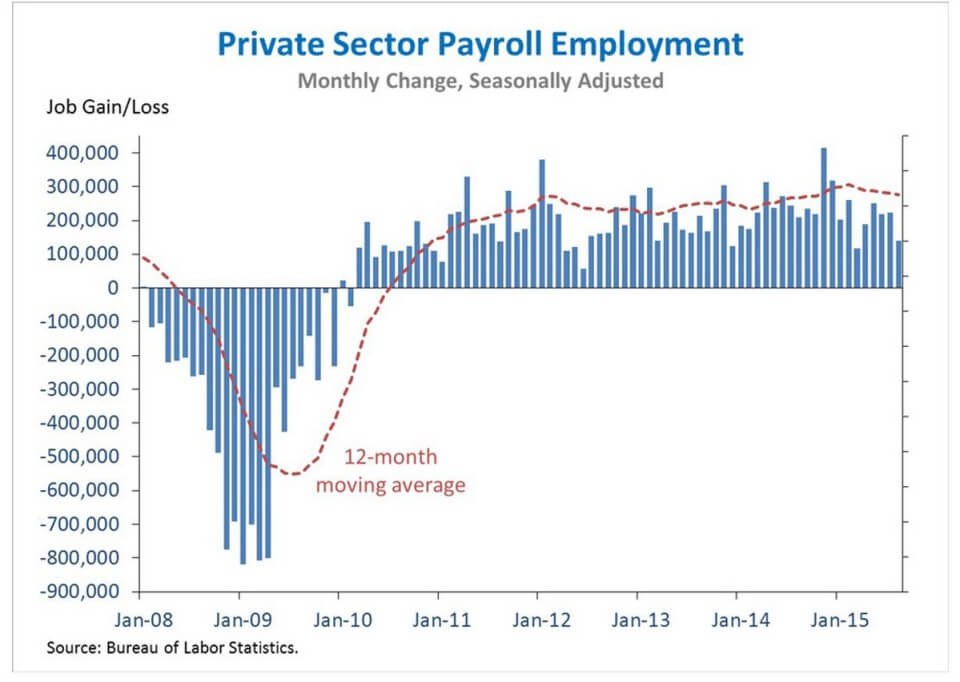Ricochet is the best place on the internet to discuss the issues of the day, either through commenting on posts or writing your own for our active and dynamic community in a fully moderated environment. In addition, the Ricochet Audio Network offers over 50 original podcasts with new episodes released every day.
 August Jobs Report: Government Jobs to the Rescue
August Jobs Report: Government Jobs to the Rescue

US job growth in August slowed from July — to 173,000 from 245,000 — as the unemployment rate fell to the lowest level since 2008, 5.1%. The Wall Street Journal offers a nice summary of the data, and what it might mean for the Federal Reserve’s upcoming interest rate decision.
Now jobs in the private sector — you know, the part of the economy producing “actual consumer-relevant value,” as economist Tyler Cowen has put it — rose by just 140,000, the smallest gain in five months. Economist Robert Brusca is unimpressed, noting that “result lies in lower 17% of its queue of results over the last 59 months when jobs have been expanding. Government jobs however are the second strongest they have been over this period. That gain is what saved the headline from further embarrassment.”
Overall, government jobs were up 33,000 while “goods-producing sectors had one of their worst months of the expansion, with employment dropping 24,000: mining got hit for another 9,000 jobs and factory employment fell by 17,000,” according to JPMorgan. Now there will be revisions, and August seems to be a month were the first print tends to undershoot. So we’ll see if the month was stronger than first appearances suggest.





James, what’s the number of new jobs necessary to keep pace with population growth? Isn’t it around 150,000? So, anything under that would theoretically increase unemployment, ceteris paribus, right?
Also, I had previously thought that unemployment would not make it down to 5.1% until the labor force participation (LFP) had increased. I figured that as unemployment fell, LFP would grow as people reentered the workforce because of brightening prospects. But, they haven’t. I hear that something like half of the decline in LFP is due to age demographics. What about the rest? Where are they?
It is because wages haven’t increased, I’ll wager. People do not make life decisions about the reported unemployment rates. They decide to work or not based on the wages that they can earn, and those are meager, so they are staying home. What say you?
Hi Inwar.
Other things being unchanged, if the Labor Force goes Down, the Unemployment Rate goes Down.
Consider the following example
Economy has 100,000 employed. Labor Force is 120,000. 20,000 are unemployed. Divided by 120,000 in labor force …. Unemployment rate is 16.7%
Economy creates no new jobs. Still 100,000 people employed. 10,000 discouraged folks drop out of the labor force. So there are only 10.000 unemployed. Labor force is 110,000
Dividing 10,000 by 110,000…unemployment rate is 9.09%
Remember, being in the labor force means you have work or are looking for work. If you have stopped looking, you’ve become invisible.
Often, at the beginning of a recovery, the unemployment rate goes UP because people hear prospects are better and they start looking for work again … That is they rejoin the labor force.
Consider. The economy described above. 100,000 employed. Labor force 110,000. Unemployed 10,000 Unemployment rate 9,09%
20,000 new jobs are created. Great! But because things are looking up, 30,000 people rejoin the labor force.
Employment is 120,000. Labor force 140,000. Unemployed = 20,000. Unemployment rate is 14.28%
This is one of the reasons Vermont’s unemployment rate is so low – the participation rate keeps dropping, and actual jobs are lost, but as long as the rate of people dropping out exceeds the number of jobs lost – poof! Instant lower unemployment rate.
The state’s governor Peter Shumlin has already announced he’s not going to run again, mostly because of single-payer, but the economy is it, too – even though he has been selling VT’s unemployment rate as far as he can, the reality is that the state’s economy is dying.
Along with his political career. So maybe there’s an upside.
I assume that the government jobs graph is also seasonally adjusted. But, I’ve been told that the seasonal adjustment for August and September isn’t particularly good, because of changes in the dates school teachers report for work. If so, the growth in government workers is overstated.